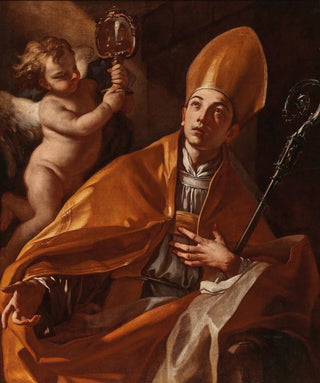Art print | The miracle of San Gennaro - Francesco Solimena


View from behind

Frame (optional)
In the vibrant universe of baroque art, the work of Francesco Solimena, "The Miracle of San Gennaro," stands out for its narrative richness and emotional depth. This iconic scene, which depicts a crucial moment of Catholic faith, transports the viewer to the heart of a millennia-old tradition, where spirituality and art converge in a fervent display. The art print of this masterpiece invites an immersion into a world where the sacred and the profane intertwine, revealing the power of artistic representation. Through vibrant colors and poignant expressions of the characters, Solimena succeeds in capturing the very essence of a miracle, making this work a true masterpiece of religious art.
Style and uniqueness of the work
Francesco Solimena's style is characterized by a dynamism and expressiveness that are uniquely his own. In "The Miracle of San Gennaro," he employs a palette of dazzling colors, creating a striking contrast between shadows and lights. The human figures, dressed in sumptuous drapery, are animated with theatrical gestures that emphasize the intensity of the scene. Each character, whether believer or skeptic, is depicted with such meticulous detail that they almost seem to come alive before the viewer's eyes. The composition is skillfully orchestrated, guiding the gaze toward the central point of the miracle, while also conveying an atmosphere of collective devotion. This work does not merely tell a story; it engages the viewer in a sensory experience where beauty and spirituality merge.
The artist and his influence
Francesco Solimena, born in 1657 in Canosa di Puglia, is one of the masters of Neapolitan baroque. His training with the great artists of his time, as well as his immersion in the artistic traditions of Naples, shaped his unique style. Solimena drew inspiration from Caravaggio's works while developing a personal approach that allowed him to stand out. His influence extends beyond his era, inspiring many artists who sought to capture the grandeur of human emotions through painting.

Matte finish

View from behind

Frame (optional)
In the vibrant universe of baroque art, the work of Francesco Solimena, "The Miracle of San Gennaro," stands out for its narrative richness and emotional depth. This iconic scene, which depicts a crucial moment of Catholic faith, transports the viewer to the heart of a millennia-old tradition, where spirituality and art converge in a fervent display. The art print of this masterpiece invites an immersion into a world where the sacred and the profane intertwine, revealing the power of artistic representation. Through vibrant colors and poignant expressions of the characters, Solimena succeeds in capturing the very essence of a miracle, making this work a true masterpiece of religious art.
Style and uniqueness of the work
Francesco Solimena's style is characterized by a dynamism and expressiveness that are uniquely his own. In "The Miracle of San Gennaro," he employs a palette of dazzling colors, creating a striking contrast between shadows and lights. The human figures, dressed in sumptuous drapery, are animated with theatrical gestures that emphasize the intensity of the scene. Each character, whether believer or skeptic, is depicted with such meticulous detail that they almost seem to come alive before the viewer's eyes. The composition is skillfully orchestrated, guiding the gaze toward the central point of the miracle, while also conveying an atmosphere of collective devotion. This work does not merely tell a story; it engages the viewer in a sensory experience where beauty and spirituality merge.
The artist and his influence
Francesco Solimena, born in 1657 in Canosa di Puglia, is one of the masters of Neapolitan baroque. His training with the great artists of his time, as well as his immersion in the artistic traditions of Naples, shaped his unique style. Solimena drew inspiration from Caravaggio's works while developing a personal approach that allowed him to stand out. His influence extends beyond his era, inspiring many artists who sought to capture the grandeur of human emotions through painting.






